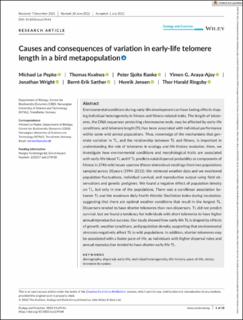| dc.description.abstract | Environmental conditions during early-life development can have lasting effects shaping individual heterogeneity in fitness and fitness-related traits. The length of telomeres, the DNA sequences protecting chromosome ends, may be affected by early-life conditions, and telomere length (TL) has been associated with individual performance within some wild animal populations. Thus, knowledge of the mechanisms that generate variation in TL, and the relationship between TL and fitness, is important in understanding the role of telomeres in ecology and life-history evolution. Here, we investigate how environmental conditions and morphological traits are associated with early-life blood TL and if TL predicts natal dispersal probability or components of fitness in 2746 wild house sparrow (Passer domesticus) nestlings from two populations sampled across 20 years (1994–2013). We retrieved weather data and we monitored population fluctuations, individual survival, and reproductive output using field observations and genetic pedigrees. We found a negative effect of population density on TL, but only in one of the populations. There was a curvilinear association between TL and the maximum daily North Atlantic Oscillation index during incubation, suggesting that there are optimal weather conditions that result in the longest TL. Dispersers tended to have shorter telomeres than non-dispersers. TL did not predict survival, but we found a tendency for individuals with short telomeres to have higher annual reproductive success. Our study showed how early-life TL is shaped by effects of growth, weather conditions, and population density, supporting that environmental stressors negatively affect TL in wild populations. In addition, shorter telomeres may be associated with a faster pace-of-life, as individuals with higher dispersal rates and annual reproduction tended to have shorter early-life TL. | en_US |

